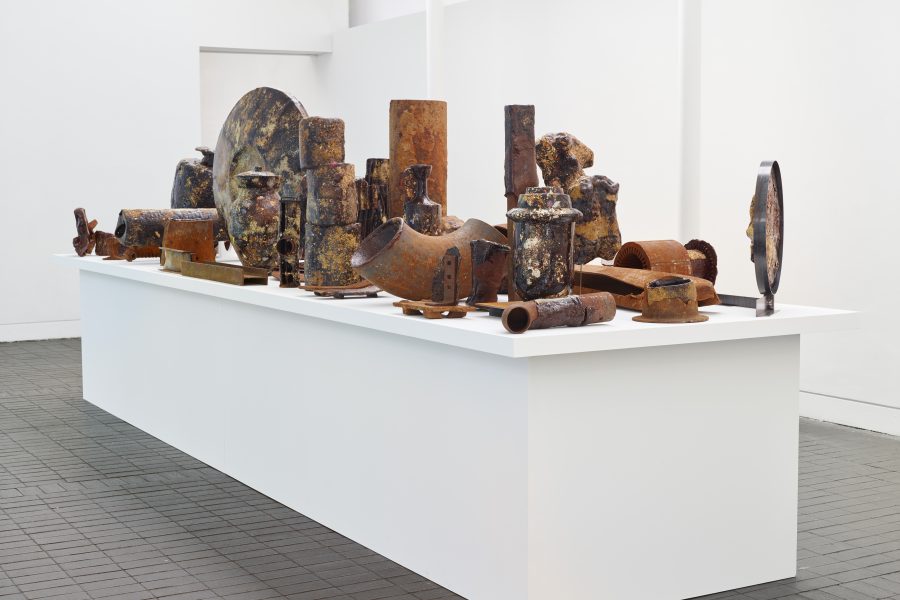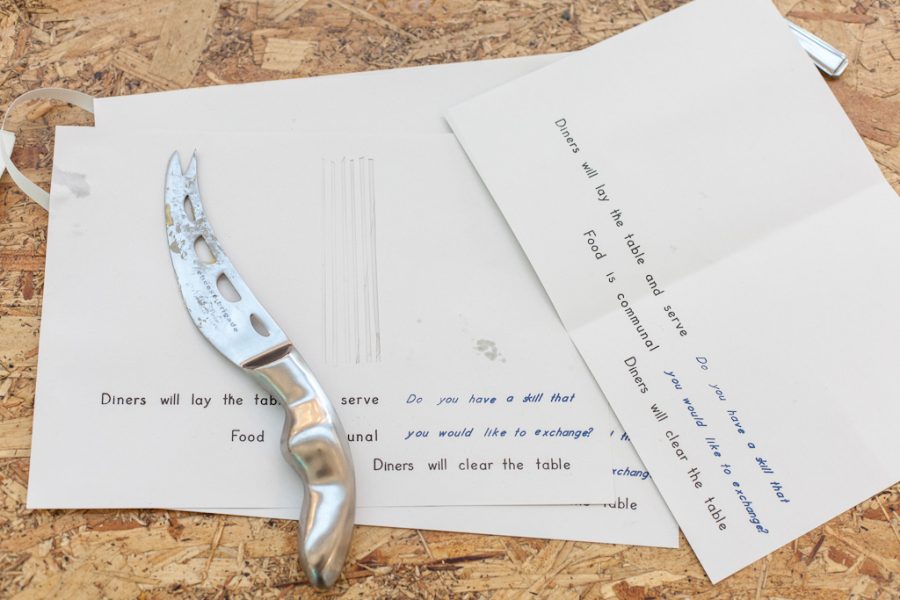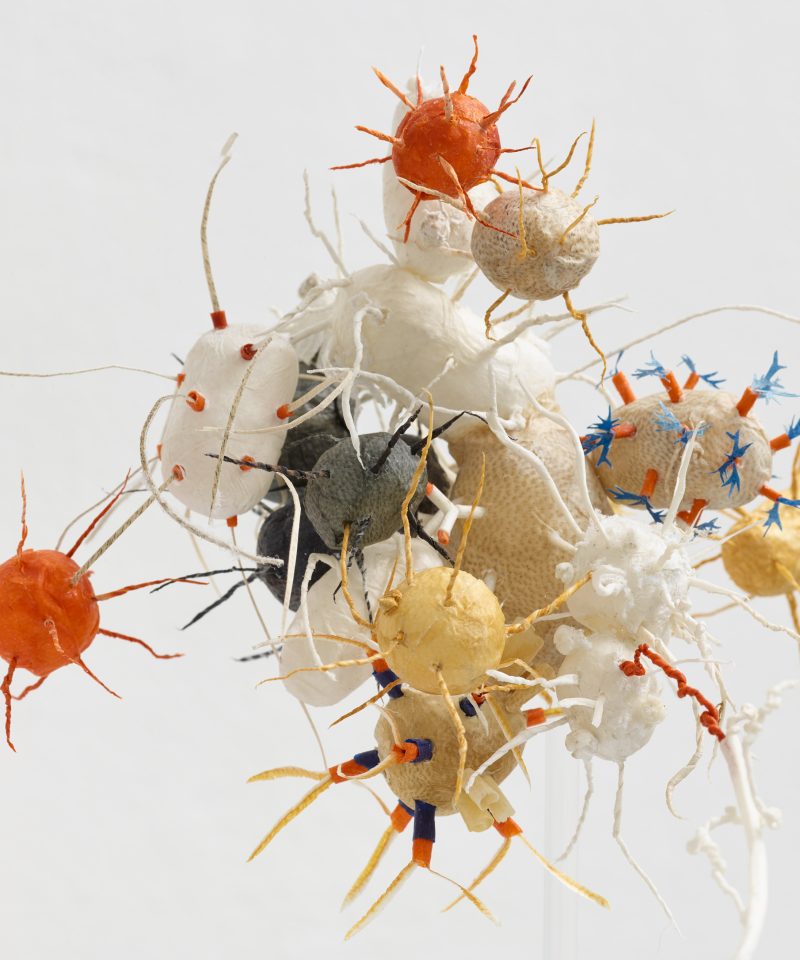Last year I was reading Leslie Jamison’s Empathy Exams. I had arrived at this text after some time spent considering the differences between sympathy and empathy; I was particularly interested in the experience of each one and what societal limitations are placed upon our assertion of them. Jamison writes: ‘empathy isn’t just something that happens to us— a meteor shower of synapses firing across the brain— it’s also a choice we make: to pay attention, to extend ourselves’.[1] Jamison proposes the idea that individuals have control over empathy: the degree in which we feel it, for whom and what we feel it for, and the practical results. This is a relevant line of enquiry to the way that I, as a writer, conduct conversations with artists in relation to the intimacies of their work. If to be empathetic is a choice of interpersonal assertion, how do we use our own experience to extend beyond the self in relation to art? And if so, can this materiality emerge as a form of storytelling, reimagining the foreclosures of bypassing personal experience and creating sociable and collaborative messages?
Empathy became the fabric of intellectual exchange between me and Laura Youngson Coll, who I interviewed at her quiet, somber studio in Crystal Palace. Surrounded by her white opaque sculptures, scientific investigations and writings, it felt as though I had infringed upon fragmented moments of intense privacy – a complex terrain between the factual and fictional self. Since losing her partner, Richard, to non-Hodgkin lymphoma in 2015, Coll’s practice has confronted the biological and emotional affects of this experience. She explains how her pieces for Jerwood Makers Open 2017 aim to ‘reconcile what’s going on at a human, physical level alongside what is happening on a microscopic level’.[2] It quickly became apparent that these sculptures embody an autobiographical, emotive language. If tacit understanding belongs to a realm of empathy and intuition, then Coll’s sculptures speak to the complexity of illness with accentuated sensitivity. Meaning is elicited from the fragility of the objects: at first they appear removed and unplaceable, but on closer inspection, they are precise, emotive and considered.
‘Silence,’ writes Audre Lorde in a 1997 article for The Cancer Journals ‘is a fear of contempt, of censure, or some judgment, or recognition, of challenge of annihilation’.[3] Lorde refers to the space whereby women collectively cease to be recognised societally for emotional and visceral experiences of loss, mortality and fear. That in essence, visibility and vulnerability are intermittently the greatest strengths people can assemble; through verbalisation we can create new narratives and stories. The fusing of autobiographical content and critique of experience bears weight on Coll’s sculptures, illuminating the finite boundary of fact and fiction merging, opening a trajectory onto unseen experiences. The reimagining and unsilencing of emotive and biological narratives are poignant in these sculptures.
Coll worked with a hematologist throughout the construction of the works, which provided her with an in depth understanding of the biology behind the illness Richard suffered. In all its foreboding, the work is tentative to the complexity of witnessing illness. Real and imaginary run throughout Coll’s practice, aesthetically accounting for what we so readily cease to visually grasp and see. Personal and scientific narratives bind these sculptures— where the unfamiliar and uncanny present itself as intertwining a more speculative scientific terrain. What enables this differentiation?
In Pathogenesis (2016) depicts Coll’s imagining of a cancer cell, based on no scientific research. They are the most emotive pieces in the series, partly due to it being the first one made after Richard died. ‘The second moves into a more biological representation of the cells,’ Coll explains. ‘Then the orange parts of the third piece are antigens, which are always on the surface of a B cell’.[4] The use of feathers reflect Coll’s discovery that birds generate protective B cell (part of the immune system) in an organ called the Bursa of Fabricius (epithelial and lymphoid organs only found in birds), which explains the etymology and naming of the B cell. A self narrative wrought by the materiality of vallecular substance, informed by objective factual information made paramount by the emotionality of Coll’s experience.
‘The naming of Angiogenesis (2017) reflects the process of a tumour creating its own blood vessel to stay alive, which I thought was really horrific’ Coll notes.[5] Visually and conceptually, this piece disturbs the viewer, down to the very notion that vessels turn red as they enter the cell. To be drawn close to Angiogenesis is to apprehend Coll’s care for Richard by virtue of the sculpture. This piece vindicates intimacy, and is both perceptual and conceptual, setting the two in opposition. It presents the contrasting of cells and their behaviour, which behave in certain ways, which are defined through a constant set of terms and medical principles.
Coll continues: ‘The works are basically entirely vellum based. There is a tension in the material and I have been working with it for years. I love that if you pare it with a surgical scalpel it becomes thin and translucent’.[6] There is a subtle significance here, between the materiality of the vellum (it is, after all, skin) and the subject matter. How can the body of another be reflected through the use of such a substance? Julia Kristeva writes about ‘shaping the body into territories, having areas orifices points and lines, surfaces and hollows’[7], which is reflective of an ambiguous material terrain apparent in Coll’s work. They are beautiful, fragile, but on closer examination present a trace of what does, quite simply, lie beneath the surface, preferring the possibilities of the future than determinates of the past.
Therein lies a mapping throughout Coll’s work. Haeckel I (2015) is in reference to the 19th century biologist Ernst Haeckel’s drawings of radiolaria. Coll explains ‘he would look down a microscope and draw what he was seeing: tiny sea organisms and cellular forms’.[8] This scientific attention to what exists beyond our perceptual realm is consistently explored in Coll’s Jerwood Makers Open 2017 commission. There is the feeling that these sculptures are a catalyst into miniature worlds, meditating on the scientific but also the artistic imagery of the artist’s experience. Although based on the biologist’s drawings, the Haeckel pieces are made up, deriving from the artist’s imagination. It is this creativity which allows their own fictional narrative to emerge.
I was intrigued by Coll’s relationship to abjection; abjection in the sense of being cast off, a state where we inhabit a conflicted disposition of the self. To use Kristeva’s words, it ‘disturbs identity, system, order’[9]. These objects re-imagine scientific language and our relationship to disease, creating a new material narrative. Coll described how ‘these works are informed by these isolated biotic systems— I have a fascination with this artifice’[10]. The artifice here is a characteristic of ambivalence: the works can neither be placed in the artistic or scientific. They reside somewhere else, where a gentle basis of shared affection become examples of emotional experience, moving away from a static position of understanding.
It is for this reason that Coll’s work ‘behold[s] the breaking down of a world that has erased its borders: fainting away’. Kristeva continues: ‘abjection is in fact recognition of the want on which any being, meaning, language, or desire is founded’.[11] Kristeva’s words are a catalyst to unravel the empathetic narrative that runs throughout Coll’s work. It breaks down emotional and scientific structures— the sculptures move beyond two states; they create their own storytelling, erasing previous connotations surrounding how we discuss loss and memory.
The third piece in the series, Regimen (2017), mimics the biological confusion of molecules. The personal references throughout the sculptures are subtle. Part of Regimen is constructed with Richard’s treatment card in twirled, bright, piercing yellow, listing the quantity of medication taken by Richard throughout his treatment. It contributes to the structure of this piece— it is one of the stalks in the molecular sculpture. When we look at Regimen we are confronted with both the organisation of circular vellum balls mimicking the cellular body, and a set of revised experiences which haunt the materiality of Regimen. It captivates a self narrative which referred back to my own, as a restoration of the self made visible to the onlooker.
*
Coll’s materiality finds its origins in the ephemeral, the tangible and at times, emotive. These moments seem to suspend themselves into a thwarted infinity, a never ending chain of possibilities which cease to know their limit. The sculptures, on first appearance, seem to demark the material space between fragility and biology. Approaching scientific discourse with this strand of personal narrative is, as Coll explains, ‘a different kind of story telling’.[12] The objective medical language Coll encountered throughout Richard’s treatment contrasted with the emotional experience, in this work it is sensitively crafted , an internal space which ceases to have an outward visibility.
Such questions unavoidably raise issues of the autobiographical and performative. Under patriarchy, women are encouraged to internalise fear as something we must conceal and control, to repress its effects on how we conduct our interpersonal relationships and the manner in which they effect how we see, feel and operate. The doubleness of how these objects are constructed remain their most poignant quality— as a material assemblage of scientific and personal narrative. Such a narrative presents vulnerability as an opening and closing; a gentle plateau of experience we are all informed and implicated in.
In bearing witness to these moments through the trajectory of making, there is an opportunity to mitigate against the clinicalisation of medical treatment. We see what Coll has done here— we see she has borne the weight of loss through the materialisation of a contingent object. The gesture of her work points to a space beyond language. ‘It is tempting to try and find a resolution in such situations’ Coll explains. It seems these artworks have evoked a resolution to some degree through their becoming. The assimilation of this narrative and experience is encompassed in these sculptures. The works, then, are a mask of fragility behind which a real life intimacy existed, still and untouched..
*
Here I return to Lorde. She writes, in reference to voicing her experience ‘it means knowing that within this continuum, my life and my love and my work has particular power and meaning relative to others’.[13] I use this to ask: on what legitimate basis might we attribute the meanings we may find in her works to her acts in making them? Coll explains ‘The sculptures reflect how you have to compartmentalise when something traumatic like this happens’.[14] It is evident in retrospect that these sculptures are an invitation to the onlooker, to engage with a substantial expression of another’s emotive experience. If to enact emotion is to extend the self to others, perhaps what we take from Coll’s sculptures is the promise of collective experience and solidarity. Emotion here is not static, it is nonlinear: it reaches to a space which is irrefutably kind and understanding, apparent in its concept and materiality.
The series of sculptures reminded me of Gertrude Stein’s ‘MORE’ from the Objects chapter in Tender Buttons, where the narrative form confronts the simplicity of domesticity and everyday objects— such as a chair or blueberries— yet unveils the complexity of how we elevate feminine communications of the everyday. Stein seems to be speaking, through the simplicity of the everyday, of oceans of emotion; of infinite terrains where objectivity and emotionality become a finite boundary for the possibility of new language from lived experience. As Stein refines through the destabilizing of linguistics, she breaks down inequalities produced through conventional language:
An elegant use of foliage and grace and a little piece of white cloth and oil.
Wondering so winningly in several kinds of oceans is the reason that makes red so regular and enthusiastic. The reason that there is more snips are the same shining very colored rid of no round color.[15]
It is striking here that the final lines of Stein’s ‘MORE’ are symptomatic to the affection and intimacy entangled within Coll’s sculptures. Stein is nonsensical; in the subterraneum platitude that her writing embodies— it rejects lawlessness and masculinity, implicating an action beyond language. This is not to say that Coll’s sculptures contain a similar agenda. But it seems here that there is a sense of something being in transition— an unmasked becoming— where the sculptures are a static assemblage of emotion, even once their elective moment has past. They stand as examples of that rare occasion when shared meanings materialise through experience; they are a preliminary denotation. As an onlooker to the work, it seems that these sculptures are a beautiful meditation on the intimacy of another’s loss, as a finite boundary between the real and imaginary.
[1] Leslie, Jamison, The Empathy Exams (London: Granta, 2014) p. 23.
[2] Author interview with Laura Youngson Coll, artist, 5 August 2017.
[3] Audre Lorde, The Cancer Journals. San Francisco: Aunt Lute Books, 1997. p. 32
[4] Author interview with Laura Youngson Coll, artist, 5 August 2017.
[5] Author interview with Laura Youngson Coll, artist, 5 August 2017.
[6] Author interview with Laura Youngson Coll, artist, 5 August 2017.
[7] Julia Kristeva, Powers of Horror: An Essay on Abjection, translated by Leon S. Roudiez (New York: Columbia University Press, 1982) p. 72.
[8] Author interview with Laura Youngson Coll, artist, 5 August 2017.
[9] Julia Kristeva, Powers of Horror: An Essay on Abjection, translated by Leon S. Roudiez (New York: Columbia University Press, 1982) p. 13
[10] Author interview with Laura Youngson Coll, artist, 5 August 2017.
[11] Julia Kristeva, Powers of Horror: An Essay on Abjection, translated by Leon S. Roudiez (New York: Columbia University Press, 1982) p. 5
[12] Author interview with Laura Youngson Coll, artist, 5 August 2017.
[13] Audre Lorde, The Cancer Journals. San Francisco: Aunt Lute Books, 1997. p. 10
[14] Author interview with Laura Youngson Coll, artist, 5 August 2017.
[15] Gertrude Stein, Tender Buttons (1914: New York: Haskell, 1970) p. 11



